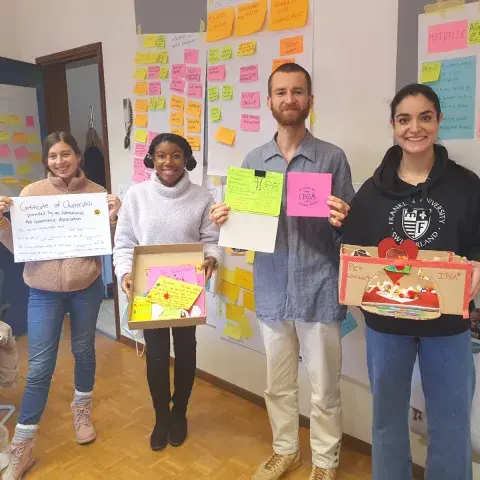
Dr. Michael Lewrick is a best-selling author, award-winning design thinking and business ecosystem design thought leader, business entrepreneur and visiting professor at many universities, including Franklin University Switzerland. His innovation and management approaches are iterative, agile, and bold, and with his help, a number of international companies have developed and implemented radical innovations. Franklin Master of Arts and Science students had the opportunity to engage with Dr. Lewrick in the recently concluded course on design thinking, where he delivered a unique and captivating learning experience. Here are his views and thoughts on the application of innovation and design thinking.
Franklin: How can you tell that an innovation project is successful?
Dr. Lewrick: The real "success" lies in how you get from the identified problem to a market opportunity, which corresponds to the real "innovation work", i.e. the power, time and energy spent to turn all insights gathered into what we call and define as "innovation". To get from the thought state of an initial problem statement to a market opportunity, three perspectives should therefore be asked and fulfilled in order to be successful:
1. Desirability, do we address a customer need, and do customers want to spend money on it?
2. Feasibility, do we have a (technical) solution to make the market opportunity accessible to the customer?
3. Viability, do we have a viable business model or ecosystem in place that allows us to realize, grow and scale the market opportunity?
Franklin: How do you get students to work in design thinking mode and create radical innovation?
Dr. Lewrick: When students are asked to "innovate" and "hunt for the next market opportunity" there is a tendency to follow the beaten path because it is well lit and easy to accomplish. That is, students rarely dare to stray from the path to enter the "jungle" of the unknown. Therefore, it is all the more important to help students increase their capacity to act, instilling curiosity in them so that they can courageously leave the "clogged innovation highways" that are populated with great preference in universities and lecture halls. Students who are given the opportunity to leave the existing path can develop a pattern over time to materialize new market opportunities and innovation. It's not a recipe for innovation, but it's useful strategies and techniques that are highly likely to be replicated.
Franklin: Can a mindset like design thinking be learned and trained in a structured university setting?
Dr. Lewrick: A resounding yes! And I particularly focus on project-based learning in my training and university courses. This means that interdisciplinary student teams work on concrete problems, which they solve in a team of teams approach. In the end, students reflect on what they have learned from the project as well as from the application of design thinking. Learning also means building bridges to other disciplines and to enable them to choose the appropriate method. It is important to teach students where they stand in the design thinking process and how the mindset contributes to being successful in the respective design challenge.
Franklin: Is innovation given a higher priority in the working world today than it used to be?
Dr. Lewrick: In the past, there was above all a great striving for efficiency. In the age of industrialization, employees performed the same highly specialized tasks over and over again. Today, it's different, because as we globalize, we're implementing technologies that allow us to share knowledge and information at any time. Organizations need to transform to overcome the digital divide, for example, and this can only be done with employees and university graduates who are brave enough to "leave the lit highways".
Franklin: Where is the journey going, what are trends in innovation management?
Dr. Lewrick: The boundaries of our obvious world and our known systems are no longer predictable - they are changing. Our corporate world is complex, complicated, dynamic, and interconnected, and one thing is certain, the future will be different than the past. The good thing, however, is that every single of our Franklin graduates - the next generation of leaders - can help shape the future. The times we live in are exciting and much more challenging than 5, 10 or 20 years ago, but it's also a lot of fun to see how daring ideas can become great success stories. And the next revolution in business models is forming right now, the design of business ecosystems. So let's get to it!

